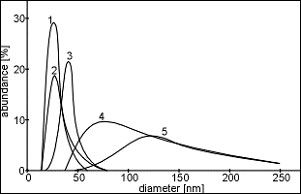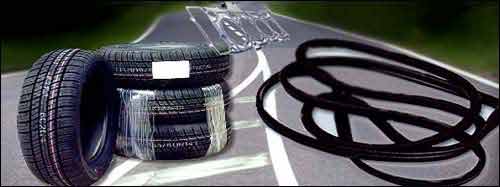Carbon blacks are typically elemental Carbon that is available in
highly dispersed powdered forms. They are produced from hydrocarbons by
controlled vapour-phase pyrolysis.
Carbon Black is one of the most important types of pigments that have major
industrial applications. In Producing Carbon Black there are numerous
processes available. Mostly all the production processes depends on thermal
decomposition or incomplete burning of fuel oil or natural gas (hydro
carbons). Majority of all carbon black is made by employing the furnace
process. "Furnace black" and "channel black" are the two
very popular variants of Carbon Black. Others include acetylene black, lamp
black and thermal black. Mostly all types of Carbon blacks contain oxygen,
hydrogen, nitrogen and sulphur.
Characteristics of Carbon Black
- Average particle diameter: In most of the commercially-produced
carbon blacks the range is from 0.01 to 0.4 micrometres (µm)
- Average aggregate diameters: Ranges from 0.1- 0.8µm
- Percentage of Elemental Carbon: Between 97 to 99
- Particle size: The following graph shows the particle size of some
carbon black pigments.

- Channel Black
- Furnace Black
- Acetylene Black
- Lamp Black
- Blacking
The requirements of applicability of Carbon Black
are critical, their importance also vary according to application. Few such
requirements are discussed here:
 Color
Strength-
Color
Strength- Colour strength of a few type of carbon Black pigment as
appearing in Acrylonitrile butadiene styrene (ABS) polymer is shown in the
graph.
Masterbatch Dilutability- Masterbatch dilutability is approximated
and compared by the process of measuring the melt viscosity of a given
masterbatch formulation. In fact masterbatch dilutability is critical. In
the selection of the right carbon black and can result in saving substantial
formulation cost.
UV Stability- By addition of carbon black, the stability with regard
to UV rays can be increased.
Carbon Black Dispersability
Blue Tone
Carbon black is widely used into many horizons.
This include other than pigmenting, applications like UV stabilizing and as
a conductive agent in a vast number of specialty products.
Popular applications include:
Thermoplastic moulding- Some of the significant applications of
carbon black are shown here. Prominent application is found in automotive
applications.
 (Steering and Dash Board system of a car using Carbon Black Pigment)
Toners and Printing Inks-
(Steering and Dash Board system of a car using Carbon Black Pigment)
Toners and Printing Inks- Carbon black enhance formulations and
offer broad flexibility in terms of specific color requirements.
Applications of carbon Blacks include Letterpress, Lithographic, gravure,
flexographic, and screen printing processes. It is important here to know
that each of these processes needs different performance attributes.
Plastics- Used in plastic masterbatch applications, like films,
conductive packaging, pipes, fibers, moldings, and semi-conductive cable
compounds.
Flexography ink- This ink is fluid, with instant drying features.
Rheology is a vital factor here. Carbon Black pigments with low oil
adsorption pigments are a must.
Offset printing- A high color strength along with high pigment
loadings, smooth flow, and a viscosity that is fairly working are needed
from the application of Carbon Black. Offset ink must not be miscible with
water. If the requirement is high gloss then lower oil absorption pigments
are required.
Coatings- Carbon blacks provide coating applications for sectors
like marine and aerospace. By way of pigmentation, conductivity and UV
protection.
Screen Printing- The critical performance factors are rheology, low
viscosity. This can be achieved by pigment blacks that has higher
structures. Optical density property can be obtained by relatively low
pigment black loadings.
Industrial Rubber Products and Tyres- Carbon black is applied for
uses like innerliners for tyres, sidewalls and treads, for industrial rubber
products, usages include belts, hoses and gaskets. In fact a majority of the
Carbon Black that is produced goes into the making of reinforcing filler for
use in tyres and other rubber article.

Carbon Black exposure can be hazardous in some
cases. Typical classes of chemicals with carcinogenic nature like polycyclic
aromatic hydrocarbons (PAHs), sulphur-containing PAHs, nitro derivatives of
PAHs are adsorbed on to surface of carbon black.

![]() Profile
Profile ![]() Product Range
Product Range![]() Industries
Industries![]() Infrastructure
Infrastructure![]() Our Quality
Our Quality![]() Custom Manufacturing
Custom Manufacturing![]() Network
Network![]() Contact Us
Contact Us![]() Send Enquiry
Send Enquiry


![]()

 Color
Strength- Colour strength of a few type of carbon Black pigment as
appearing in Acrylonitrile butadiene styrene (ABS) polymer is shown in the
graph.
Color
Strength- Colour strength of a few type of carbon Black pigment as
appearing in Acrylonitrile butadiene styrene (ABS) polymer is shown in the
graph. (Steering and Dash Board system of a car using Carbon Black Pigment)
(Steering and Dash Board system of a car using Carbon Black Pigment)
![]() Profile
Profile
![]() Product
Range
Product
Range![]() Industries
Industries![]() Infrastructure
Infrastructure![]() Our
Quality
Our
Quality![]() Custom
Manufacturing
Custom
Manufacturing![]() Network
Network![]() Contact
Us
Contact
Us![]() Send
Enquiry
Send
Enquiry